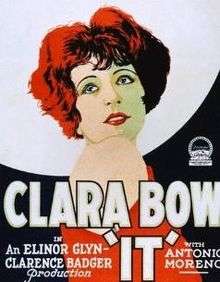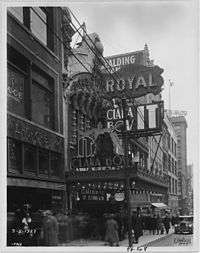It (1927 film)
| "It" | |
|---|---|
 | |
| Directed by |
Clarence G. Badger Josef von Sternberg (uncredited) |
| Produced by |
Adolph Zukor Jesse L. Lasky B. P. Schulberg |
| Written by |
Elinor Glyn (story and adaptation) George Marion, Jr. (titles) |
| Screenplay by |
Hope Loring Louis D. Lighton |
| Based on |
"It" by Elinor Glyn |
| Starring |
Clara Bow Antonio Moreno William Austin |
| Cinematography | H. Kinley Martin |
| Edited by | E. Lloyd Sheldon |
| Distributed by | Paramount Pictures |
Release dates |
|
Running time | 72 min. |
| Country | United States |
| Language |
Silent English intertitles |
"It" is a 1927 silent romantic comedy film that tells the story of a shop girl who sets her sights on the handsome and wealthy boss of the department store where she works. It is based on a novella by Elinor Glyn that was originally serialized in Cosmopolitan magazine.
This film turned actress Clara Bow into a major star, and led people to label her the It girl.
The film had its world premiere in Los Angeles on January 14, 1927, followed by a New York showing on February 5, 1927. "It" was released to the general public on February 19, 1927.
The picture was considered lost for many years, but a nitrate-copy was found in Prague in the 1960s.[1] In 2001, "It" was selected for preservation in the United States National Film Registry by the Library of Congress as being "culturally, historically, or aesthetically significant".
Plot
Spunky shopgirl Betty Lou Spence (Clara Bow) has a crush on her handsome employer, Cyrus Waltham, Jr. (Antonio Moreno), the new manager of and heir to the "world's largest store". However, they belong to different social classes, and he is already romantically linked to blond socialite Adela Van Norman (Jacqueline Gadsden). Cyrus's silly friend Monty (William Austin) notices Betty, though, and she uses him to get closer to Cyrus.
When she finally gets Cyrus's attention, she convinces him to take her on a date at Coney Island, where he is introduced to the proletarian pleasures of roller coasters and hot dogs, and has a wonderful time. At the end of the evening, he tries to kiss her. Betty Lou slaps his face, and hurries out of his car and into her flat, but then peeks out her window at him as he is leaving.
Betty bravely proclaims herself as an unmarried mother to protect her sickly roommate Molly (Priscilla Bonner) from having her baby taken away by a couple of meddling welfare workers. Monty arrives at just the wrong moment, forcing Betty to continue the charade with him. He tells Cyrus. Although he is in love with her, Cyrus offers her an "arrangement" that includes everything but marriage. Betty Lou, shocked and humiliated, refuses, quits her job, and resolves to forget Cyrus. When she learns from Monty about Cyrus's misunderstanding, she fumes, and vows to teach her former beau a lesson.
When Cyrus hosts a yachting excursion, Betty Lou makes Monty take her along, masquerading as "Miss Van Cortland". Cyrus at first wants to remove her from the ship, but he cannot long resist Betty Lou's it factor; he eventually corners her and proposes marriage, but she gets him back, by telling him that she'd "...rather marry his office boy," which accomplishes her goal, but breaks her heart. He then learns the truth about the baby, and leaves Monty at the helm of the yacht to go find her. Monty crashes the yacht into a fishing boat, tossing both Betty Lou and Adela into the water. Betty Lou saves Adela, punching her in the face when she panics and threatens to drown them both. At the end of the film, she and Cyrus reconcile on the anchor of the yacht, with the first two letters of the ship's name, Itola, between them. Monty and Adela are upset at losing their friends, but it is implied they pursue a relationship with each other as the film ends.
The concept of "It"
The invention of the concept It is generally attributed to Elinor Glyn, but already in 1904, R. Kipling, in the short story "Mrs. Bathurst" introduced It.[2][3][4]
It isn't beauty, so to speak, nor good talk necessarily. It's just 'It'. Some women will stay in a man's memory if they once walk down the street.[5]
In February 1927 Cosmopolitan published a two-part serial story in which Glyn defined It.
That quality possessed by some which draws all others with its magnetic force. With 'It' you win all men if you are a woman and all women if you are a man. 'It' can be a quality of the mind as well as a physical attraction.
Production
Paramount Pictures paid Glyn $50,000 for the concept, gave her a small part in the film as herself, and gave her a "story and adaptation" credit.[6]
Hope Loring, Louis D. Lighton and George Marion Jr. (titles) wrote the screenplay and Carl Sandburg noted that Glyn's magazine story was "not at all like the film, not like it in any respect."[7] In the original version of the story, the character with the magnetic personality was a male. Paramount producers suggested the character be female. Also the original female character, Ava Cleveland, was upper class whereas Betty Lou is working class. Nevertheless, Glyn was fully involved in the film adaptation and was very flexible about the transition.[8]

This is one of the first examples of a "concept film", as well as one of the earlier examples of product placement. The concept of "It" is referred to throughout the film, including the scene where Glyn appears as herself and defines "It" for Mr. Waltham. Cosmopolitan magazine is featured prominently in a scene where the character Monty reads Glyn's story and introduces it to the audience.
Stage actress Dorothy Tree had her first film role in a small, uncredited part. A young Gary Cooper was cast in a minor role as a newspaper reporter.
Reception
"It" was a hit with audiences all over the United States, breaking box office records. Critics praised the film, especially its star, as "a joy to behold".[9] "It" turned Clara Bow from an up and coming movie actress into the biggest movie star of the 1920s who in the process became a film legend as a result of "It". The term "The It girl" has since entered the cultural lexicon.
See also
- The House That Shadows Built (1931 promotional film by Paramount)
References
- ↑ Lynn Langway, July 26, 1970, San Antonio Express
- ↑ March 9, 1930, New York Times
- ↑ April 17, 1932, Galveston Daily News
- ↑ August 25, 1955, San Antonio Light
- ↑ Mrs. Bathurst, R. Kipling
- ↑ J. Morella and E. Epstein, The 'It' Girl, Delacorte Press, 1976, page85, ISBN 0-440-04127-9
- ↑ February 11, 1927, Film Reviews and Essays, 1920–1928, Lake Claremont Press, 2000
- ↑ Weedon et al. (2014) Elinor Glyn as Novelist, Moviemaker, Glamour Icon and Businesswoman , Ashgate Publishing, Ltd., London and Burlington, VT ISBN 978-1-4724-2182-1
- ↑ Stenn, David, Clara Bow: Runnin' Wild, Pg. 86, 1988 Penguin Books, a Division of Viking Penguin, New York, New York, originally published by Doubleday, New York, New York
External links
- It at the American Film Institute Catalog
- It at the Internet Movie Database
- It at the TCM Movie Database
- It at AllMovie